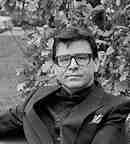Ivaan Kotulsky
Ivaan Kotulsky was an artist and photographer, working in Toronto, Ontario.[1][2][3] According to an interview with his widow, Eya Donald Greenland Kotulsky, he was born in a Nazi slave labor camp, during World War 2. Kotulsky had a distinguished career as a photographer, producing portraits of high profile individuals, like Prime Minister Pierre Elliot Trudeau. Kotulsky also documented the lives of street people, and that collection of photos has been donated to the City of Toronto archives, which organized a gallery show, to celebrate their acquisition, and subsequently made them available for download.[4][5][6]
Kotulsky was born while his mother was in a slave labor camp in Koln, in the final months of World War 2, during an allied bombing raid.[2] In 1949 his family immigrated to Canada, sponsored by a blacksmith in Smoky Lake, Alberta. By 1954 his family had moved to Toronto's Cabbagetown, near the Don Valley ravine, which provided a slice of nature in downtown Toronto for Ivaan to explore. Kotulsky would later credit his exposure to the kindly blacksmith as kindling his own interest in metalworking which found its outlet in jewelry making when he was an adult.
Kotulsky was said to have been able to see beauty in things people ordinarily over-look, explaining the quality of the intimate images he took of street people.[1] The engagement ring he crafted for his wife featured a very large green stone -- which was originally a discarded soda pop bottle.
In 2000 Kotulsky experienced the first of a series of strokes that that began to erode his ability to create new works of art.[7]
Kotulsky was to marry Eye Donald Greenland in 1995, after meeting her, and befriending her, when she worked at the bakery he frequented in 1969, when she was 16 years old.[3] After his first strokes, when he lacked the strength and dexterity to continue making jewelry by himself, she started to assist him in preparing jewelry from his existing molds, using the lost wax technique. She told Nicole Baute, writing in the Toronto Star, that she never intended to continue making pieces from those molds, after he died, beyond filling the outstanding orders, but customers continued to request pieces, and then the Art Gallery of Ontario, which had commissioned Kotulsky to create art work inspired by King Tut, in 1979, when they hosted a long-running exhibition of King Tut artifacts, requested she prepare additional copies when they hosted a second exhibition of King Tut artifacts in 2009. She continues to run his atelier due to ongoing demand for copies of his jewelry.
Baute reported that Kotulsky became the " first Canadian to undergo a pioneering neurosurgical procedure," to close off the damaged artery that had caused his four strokes and two heart attacks.[3] She reported that the surgery successfully closed off the artery, but that Kotulsky suffered a final stroke, that put him in a coma from which he never recovered, dying on December 6, 2008.
References
- ↑ 1.0 1.1 Ania Romaniuk (2013). "Interview at Atelier Ivaan: Renaissance Man Ivaan Kotulsky". Ink Noir. http://www.inknoir.com/interviews/interview-at-atelier-ivaan-renaissance-man-ivaan-kotulsky/. Retrieved 2014-03-10.
- ↑ 2.0 2.1 "SWEEPINGS: TREASURES FROM THE ATELIER FLOOR Artefacts from the Creative Life of Ivaan Kotulsky". Ukrainian Canadian Art Foundation. 2008-09-12. http://kumfgallery.com/sweepings-treasures-from-the-atelier-floor-artefacts-from-the-creative-life-of-ivaan-kotulsky/. Retrieved 2014-03-10. "The second circumstance was the family’s immigration to Canada in 1949, to the town of Smoky Lake, a farming community in northern Alberta. Here, Ivaan bore witness to a harsh reality: his frail father’s physical labour was the only key that might open the door to prosperity in the New World."
- ↑ 3.0 3.1 3.2 Nicole Baute (2009-11-19). "Rediscovered jewellery, fit for a king". Toronto Star. http://www.thestar.com/life/2009/11/19/rediscovered_jewellery_fit_for_a_king.html. Retrieved 2014-03-10. "Last December, Kotulsky became the first Canadian to undergo a pioneering neurosurgical procedure at Toronto Western Hospital to close off the damaged artery. Although the surgery itself was successful, he had a massive stroke, never regained consciousness, and died shortly after. He was 64."
- ↑ Jamie Bradburn (2013-06). "From the Toronto Archives, a Photographic Record of Street Life: The City of Toronto Archives shows off its collection of street photography". The Torontoist. http://torontoist.com/2013/06/from-the-toronto-archives-a-photographic-record-of-street-life/. Retrieved 2014-02. "The genre of street photography is the focus of “Life on the Grid”, a new exhibit inspired by the City of Toronto Archives‘ recent acquisition of photos taken by Ivaan Kotulsky between 1990 and 2000. Almost every day, before he died in 2008, Kotulsky shot pictures of people outside his jewellery business near Queen Street West and Euclid Avenue, creating a record of the neighbourhood’s street life."
- ↑ "Ivaan Kotulsky". Globe and Mail. 2008-12-08. http://v1.theglobeandmail.com/servlet/story/Announcements.20110901.93273576/BDAStory/BDA/births. Retrieved 2014-03-08.
- ↑ "Life On The Grid: 100 Years of Street Photography in Toronto". Torontoism. 2013-09-22. http://torontoism.com/toronto-news/2013/09/life-on-the-grid-100-years-of-street-photography-in-toronto. Retrieved 2014-03-10. "This new showcase was kick-started when the City of Toronto Archives acquired a large collection of photos belonging to the late avid street photographer Ivaan Kotulsky. His collection of photos was captured from 1990 to 2000 and depicted the startling reality of life on the streets of Toronto."
- ↑ Zoe Cormier (2003-11-17). "Stimulating research". The Varsity. http://thevarsity.ca/2003/11/17/stimulating-research/. Retrieved 2014-03-10. "Dr. Popovic’s patients show similar enthusiasm. “I was thrilled to death right off the bat to be one of the lucky ones to be included in the electric chair program,” jokes Ivaan Kotulsky, who lost the use of his right arm after his second stroke in December of 2002."
